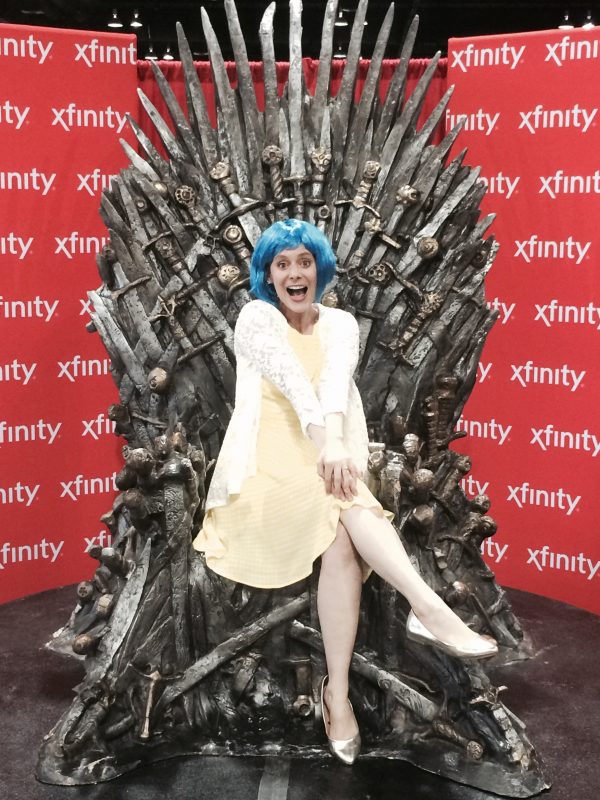
I was so excited about the release of Inside Out, I dressed up as Joy for Denver Comic Con weeks ago. Nobody knew who I was. I didn’t mind. After all, I was Joy.
Five years in the making, Inside Out unfolds in the mind of an 11-year-old Riley, whose faces a crisis when her family uproots her from small-town Minnesota to move to San Francisco.
The snafus that follow—a lost moving truck, a sketchy start-up, a wincing-oh-so-painful first day of school, and a sports try-out turned disaster—transform the happy-go-lucky pre-teen into a short-tempered, angry tweener, with the a bad case of the G-pains, the growing pain, that occur whenever one waves buh-bye to a life built, loved, known.
Never content with a shallow story, the writer-director Pete Docter (Up) digs deep into the anthropomorphized feelings lodged in Riley’s mind.

Joy = Amy Poehler = cast perfection = group leader
Disgust = Mindy Kaling = can you hear “Mindy” saying “Ew!”?
Fear = Bill Hader = a skittish, shy character until he’s afraid
Anger = Lewis Black = no one could blow their hat better
Sadness = Phyllis Smith = Office fans will adore = brilliant performance
The opening of the film feels like being thrust into a Psychology 300 course. An exposition and information dump.
Before you can navigate Riley’s emotional world (or your own) there’s much to learn.
Riley’s personality is represented and shaped by a series of island including Family, Honesty, Goofy, and Hockey. Her mind is filled with a Long Term Memory facility (inspired by a real Jelly Belly candy factory). Imagination land is magical place of possibilities. Dreams are scripted and filmed in a mini-Hollywood studio ironically not named DreamWorks.
Not all is light and fluffy. Abstract thinking can flatten and distort anyone who enters. The Subconscious is a dark place dreams become nightmares.
All this may seem random and hard to follow for those of us who managed to graduate from college without taking Psychology (or at least showing up to class).
Keep watching. Once your mind is stuffed with the necessary details, Pixar kicks the plot into second gear as Joy goes on an unforgettable journey.
Without spoiling the movie, here are 5 Myths Inside Out exposes about our emotions.

Myth #1: Joy can exist apart from sadness.
Through the film, Inside Out opens our hearts to the importance of grieving and acknowledging loss. Though may of us are tempted to run from the pain of loss, sadness can unleash a healthy opportunity for healing, community, and maturity.
Sometimes readers are surprised that I talk so much about grieving and offer practical suggestions on how to grieve in Fight Back With Joy book and Bible Study. But joy is found in both the morning and the mourning. Inside Out displays this well.
Myth #2: Nothing good can come from disgust.
Every kid has at least one food they can’t stand. Disgust first appears in Riley’s life when tree-like green vegetables (also known as broccoli) approach her lips. Disgust is such a, well, repulsive emotion we may be tempted to hide it. In the proper scenario, this is an expression of grace and maturity. But disgust—whether toward injustice or filth or lack of sanitation—invite us to action, to remedy, to fight for healing and human dignity.
Myth #3: Getting angry doesn’t accomplish anything.
Inside Out teaches that an expression of anger—yes, anger literally blows his top—is the call to action. Anger calls us to move beyond feeling to doing. Anger can be used for harm, also used for much good. We can learn to use our anger to become better people and give voice to those who don’t have one.
Myth #4: The way we feel about our memories is accurate.
The lenses of perception, time, influence, and awareness skew our memories. How we feel about something that happened to us today or decades ago may or may not be an accurate reflection how we felt in the moment.
This provides one of the richer aha! moments of Inside Out. Sometimes for healing to take place, we must change the lenses with which we see past event.
Myth #5: No fear is a good motto.
The portrayal of Fear by Bill Hader as a dopey, skittish character challenges our notions of fear. I imagined fear would be scary, not the scared one. Yet this portrayal reveals how fear can serve to protect us.
Hershey gives Disney Pixar’s Inside Out four paws up, a must-see for your family this summer.
What myths have you heard about emotions? What recent movies would you recommend seeing?







